
18 White Kitchen Interior Design Ideas to Inspire Your Next Remodel
A white kitchen offers a timeless foundation for diverse design styles, from historic farmhouse charm with apron-front sinks and reclaimed wood, to modern minimalism using streamlined cabinetry and light-reflective materials. Marble countertops, bold accent furniture, and artistically mixed materials create strong visual statements, while open shelving and vertical storage maximize function in compact spaces. Warmth can be introduced with oak flooring or brass hardware. Explore inventive layouts and creative color accents for further transformative ideas ahead.
Key Takeaways
- Blend original elements like apron-front sinks and vintage cabinetry with modern features to create a timeless, character-rich white kitchen.
- Incorporate bold marble countertops or backsplashes for striking focal points and sophisticated texture in a white kitchen.
- Use open shelving and vertical storage to maximize space, enhance functionality, and showcase curated dishware or decor.
- Warm up white kitchens with wood accents such as flooring, exposed beams, or butcher block countertops for inviting contrast.
- Add personality with colorful bar stools, vibrant artwork, or patterned banquette seating to create visual interest and individuality.
Cozy Cottage Charm
While contemporary trends often lean toward minimalism, the enduring appeal of a cozy cottage kitchen lies in its harmonious blend of a white color palette with subtle accents, such as a silvery blue ceiling.
White kitchens, when anchored by period-inspired elements like hand-painted backsplash tiles, evoke the bespoke charm of 1920s interiors. Expert designers recommend white cabinetry and countertops to optimize light reflectivity, enhancing spatial perception and fostering an inviting, airy environment.
White kitchens paired with period details and hand-painted tiles create a luminous, inviting space reminiscent of timeless 1920s charm.
The integration of rustic details—vintage hardware, reclaimed wood shelves, and natural materials—complements the pristine backdrop, reinforcing the kitchen’s role as a convivial hub for family gatherings.
A butcher block island not only serves as a stunning focal point but also adds warmth and functionality to the space, offering a perfect blend of rustic charm and modern elegance.
Practical solutions such as layered lighting and easy-to-maintain surfaces guarantee that the classic cottage aesthetic remains functional, stylish, and enduring in contemporary home design.
High Contrast Accents
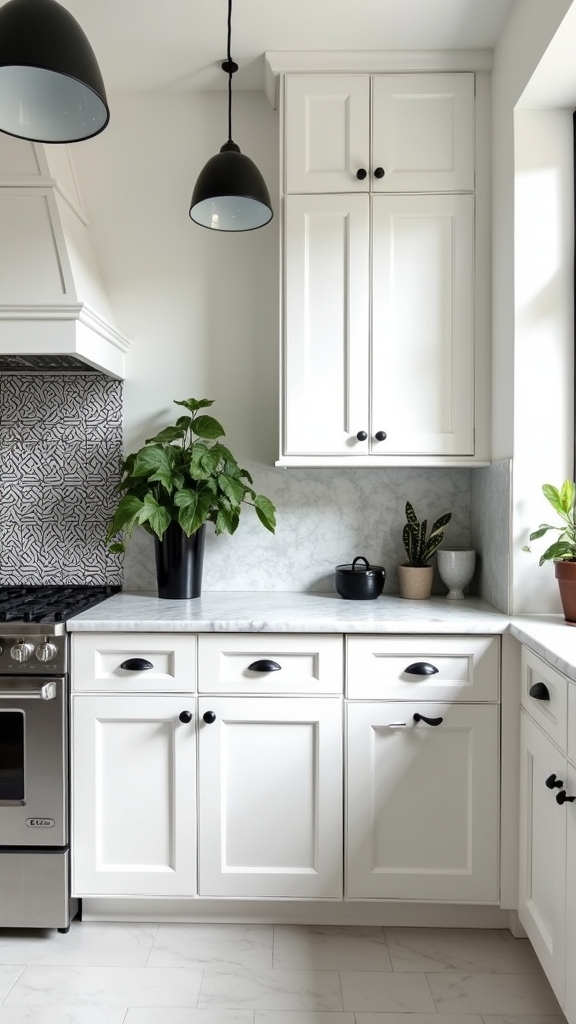
High contrast accents, such as black cabinetry paired with pristine white surfaces, introduce dynamic visual tension and underscore architectural features within the kitchen. Bold marble statements—particularly Carrara marble with pronounced veining—offer both opulence and durability for worktops and splashbacks. Strategic integration of these elements enhances the modern aesthetic while ensuring the space remains highly functional. Additionally, mixing matte and glossy finishes on cabinetry can create a captivating visual interplay that adds depth and sophistication to the overall kitchen design.
Black and White Pairings
When executed with intention, black and white pairings introduce dynamic contrast that enhances kitchen interiors into visually compelling spaces.
High contrast black cabinetry juxtaposed with a pristine white Carrara marble island exemplifies modern sophistication, particularly suited for bachelor pads seeking visual impact. The strategic inclusion of black accents—such as a matte vent hood or streamlined hardware—elevates the elegance of an all-white kitchen without overwhelming the design.
Employing black countertops or backsplashes against white cabinetry delivers architectural depth, supporting both minimalist and glamorous aesthetics. This timeless palette adapts seamlessly across design genres, offering versatility for evolving tastes.
White walls paired with prominent black elements yield a contemporary focal point, proving that monochrome combinations are both practical and enduring in high-traffic kitchen environments.
Bold Marble Statements
Building upon the striking visual interplay of black and white pairings, bold marble statements introduce a new dimension of luxury and refinement to white kitchen interiors. High contrast accents—such as a Carrara marble island juxtaposed against black cabinetry—create focal points that highlight both materiality and form. The elegance of white cabinets paired with dramatic marble surfaces heightens light reflection, expanding perceived space and clarity. Marble’s unique veining, especially in varieties like Calacatta or Arabescato, guarantees each installation remains distinctive. Strategic integration of statement backsplashes or countertops establishes cohesion and raises minimalist kitchen designs.
| Design Element | Impact |
|---|---|
| Calacatta marble | Enhanced luxury, dramatic veining |
| Black cabinetry | Strong contrast, defines focal areas |
| White cabinets | Maximizes brightness, balances bold accents |
| Statement backsplash | Adds texture, visual rhythm |
Minimalist Neutrals
Minimalist neutrals achieve refined sophistication through the application of Venetian plaster, introducing a tactile, luminous quality to kitchen walls.
A sunlit neutral palette—anchored by layered whites and soft beige tones—maximizes the effect of natural light, resulting in a tranquil, expansive environment.
This approach integrates seamlessly with streamlined cabinetry and unobtrusive hardware, ensuring both visual harmony and practical maintainability.
Venetian Plaster Elegance
Venetian plaster introduces a refined layer of sophistication to white kitchen interiors. Its smooth yet subtly textured surface reflects golden sunlight to create a luminous, inviting ambiance. This artisanal finish delivers visual depth while upholding the minimalist ethos, making it an ideal choice for contemporary kitchens that value both restraint and detail.
The inherent versatility of venetian plaster, especially in neutral tones, allows the backdrop to harmonize seamlessly with diverse décor styles and accent materials. Functionally, its durability guarantees it withstands the rigors of a high-traffic kitchen while maintaining its elegant patina.
- Enhances spatial brightness by diffusing sunlight, intensifying warm undertones.
- Offers a tactile and visual layer without disrupting minimalist lines.
- Serves as a resilient surface that resists daily wear, preserving its beauty for years.
Sunlit Neutral Palette
When suffused with sunlight, a neutral palette of soft whites and understated beiges establishes a tranquil foundation for contemporary kitchen interiors.
This sunlit neutral palette leverages minimalist design principles—clean lines and uncluttered surfaces—ideal for modern spaces seeking both serenity and functionality. Textured finishes such as subtly grained cabinetry introduce depth, ensuring visual interest without disrupting the cohesive aesthetic.
To maximize luminosity, designers recommend employing light-reflective materials like high-gloss countertops and glass tile backsplashes, which intensify natural light and enhance spatial openness.
Strategic incorporation of warm accents, such as brass hardware or natural wood shelving, offers tactile contrast and warmth, elevating the overall ambiance.
This approach maintains the integrity of minimalist neutrals while infusing the kitchen with inviting, livable sophistication.
Glamorous Marble Touches
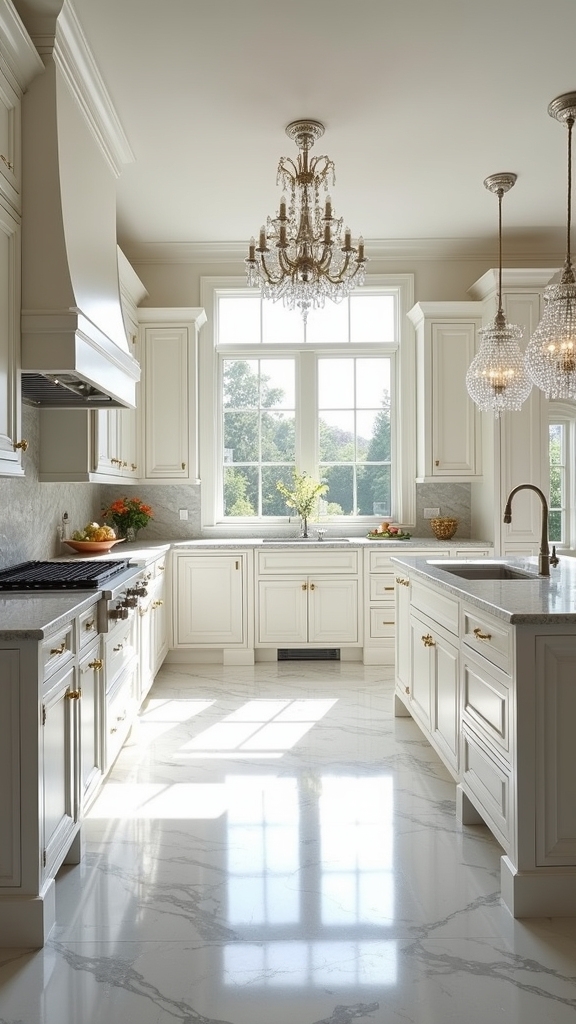
A high-contrast marble surface, such as a Carrara or Statuario marble island, instantly establishes a striking focal point within a white kitchen, anchoring the space with refined visual interest.
The bold veining and luminous sheen of marble enhance even the simplest cabinetry, achieving a harmonious interplay between classic elegance and contemporary flair.
Designers often recommend integrating marble elements to:
- Create a visually dynamic marble island that contrasts against matte or lacquered white cabinetry
- Employ marble backsplashes or countertops for a cohesive, luxurious backdrop
- Pair marble finishes with brass hardware and fixtures to introduce warmth and sophisticated texture
Marble’s natural patterns serve as both statement and backdrop, allowing for versatile styling from minimalist to opulent.
Thoughtfully selected marble touches transform the kitchen, blending timeless appeal with modern glamour.
Preserving Original Details
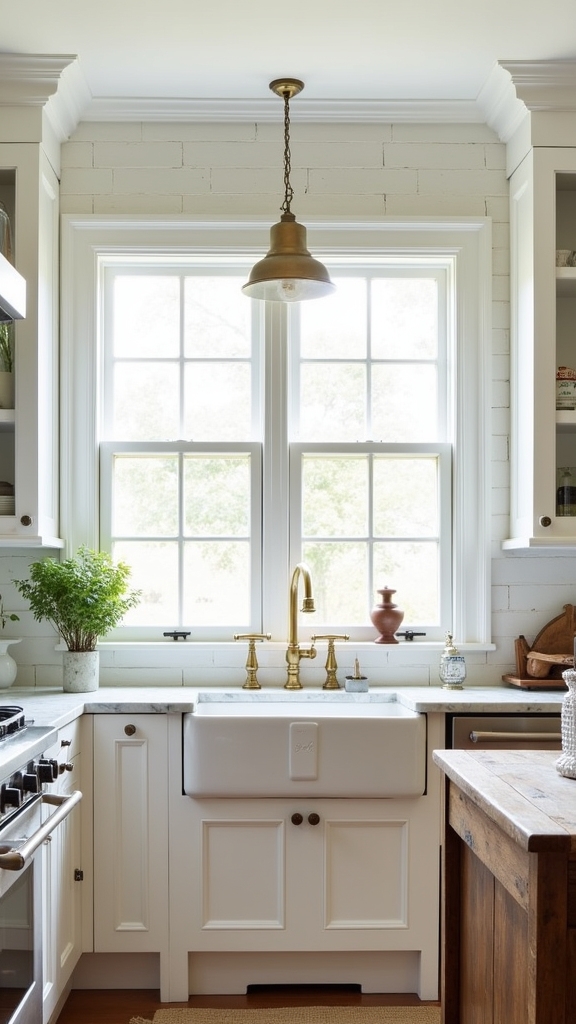
Preserving original details in a white kitchen requires honoring historic architecture through the thoughtful retention of features like apron-front sinks and vintage cabinetry.
Expertly blending old with new, designers often integrate custom cabinetry and modern appliances to guarantee both aesthetic continuity and functional efficiency.
Showcasing vintage accents—such as botanical print chairs or reclaimed wood flooring—adds distinctive character while maintaining a cohesive, heritage-inspired palette.
Honoring Historic Architecture
Often, historic kitchens reveal their enduring charm through original architectural features such as oversized apron-front sinks, hand-painted tiles, and classic butcher block islands.
Honoring these elements is essential when curating white kitchen ideas that respect the home’s architectural lineage. By preserving details like aged brass hardware on creamy white cabinetry, homeowners achieve a balance of classic appeal and modern sensibility.
Retaining original wood floors and custom cabinetry maintains the integrity of the space while ensuring daily functionality. Celebrating patina and the authenticity of materials adds depth and narrative to the kitchen’s design story.
- Preserve original features—apron-front sinks, butcher block islands—for authentic character
- Pair hand-painted tiles and aged brass finishes with white cabinetry for visual contrast
- Maintain original wood floors to anchor contemporary updates in historical context
Blending Old With New
While modernizing a white kitchen, integrating original architectural details—such as oversized apron-front sinks and butcher block islands—anchors the design in its historical context.
In kitchen design, maintaining creamy white cabinetry complemented by aged brass hardware delivers modern efficiency while preserving period character. Retaining vintage tiles and original wood flooring creates a seamless visual dialogue between new and old, reinforcing the integrity of the space.
Streamlined layouts enable the inclusion of contemporary appliances without disrupting the kitchen’s traditional core. The juxtaposition of lacquered brass pendants against crisp white cabinetry enhances the overall aesthetic, resulting in a sophisticated yet welcoming environment.
This approach guarantees that remodeled kitchens honor their architectural legacy while benefiting from advancements in materials and layout, achieving an enduring blend of style and utility.
Showcasing Vintage Accents
By intentionally highlighting vintage accents, a white kitchen can achieve both visual depth and historical resonance. Preserving original details such as aged brass hardware and painted wood floors reinforces the kitchen’s architectural integrity while infusing warmth.
Utilizing a creamy white palette balanced with natural wood tones establishes a timeless yet inviting ambiance. Functional focal points—like an oversized apron-front sink or a classic butcher block island—champion both utility and authenticity. Vintage-inspired accessories subtly enhance the aesthetic without overpowering the classic design.
- Incorporate original cabinetry and custom millwork to maintain seamless integration between old and new.
- Select period-appropriate lighting fixtures or patterned tiles for nuanced visual interest.
- Retain or restore elements such as antique hardware and wood floors to emphasize heritage within the white kitchen’s fresh context.
Mediterranean Inspiration

Embracing Mediterranean inspiration in a white kitchen centers on original cabinetry and classic tilework, which establish a fresh, coastal ambiance reminiscent of sunlit seaside villas.
To achieve this aesthetic, designers recommend integrating hand-painted backsplash tiles—a hallmark of Mediterranean design—infusing the space with artistry and cultural heritage.
Hand-painted backsplash tiles bring Mediterranean artistry and cultural heritage into the heart of the kitchen, creating a unique and timeless focal point.
Rustic flooring, such as terracotta or wide-plank wood, enhances dimension and grounds the crisp white cabinetry. Bold trim, whether in deep blue or muted terracotta, frames the space and provides visual depth.
Incorporating a vintage O’Keefe & Merritt stove offers a functional focal point while echoing nostalgic Mediterranean motifs.
Utilizing light, natural materials throughout cabinetry and decor captures the sun-drenched warmth of the region, resulting in an inviting, luminous cooking environment that is both practical and evocative.
Timeless French Farmhouse
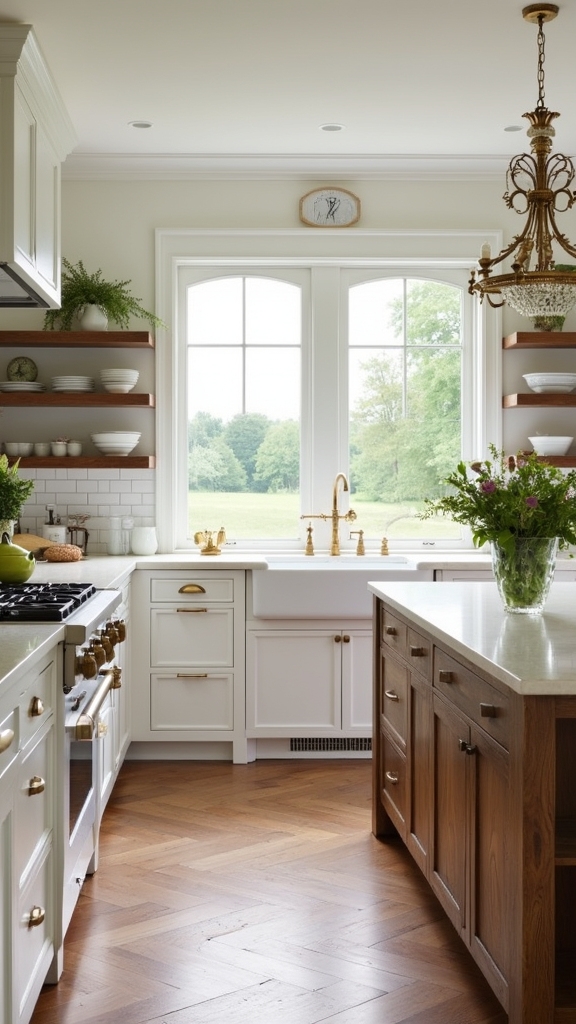
Shifting from Mediterranean vibrancy to the understated elegance of the French farmhouse, white kitchen design finds renewed expression through a blend of creamy cabinetry, natural materials, and rustic detailing.
The hallmark of a timeless French farmhouse kitchen lies in its creamy white palette, expertly complemented by exposed wooden beams and vintage-inspired hardware. Large apron-front sinks and butcher block islands serve as both practical workstations and focal points, reinforcing the room’s heritage.
Subtle beige undertones in the cabinetry and soft muted finishes evoke an airy, tranquil ambiance while retaining classic sophistication.
To further amplify authenticity and warmth, designers often rely on:
- Ornamental wrought iron fixtures
- Vintage ceramics and floral motifs
- Textured stone or wood flooring
These elements create a cohesive, inviting space grounded in tradition. Incorporating reclaimed wood into cabinetry and flooring adds unique grain patterns and weathered textures, enhancing the rustic charm and authenticity of the design.
Small Space Solutions
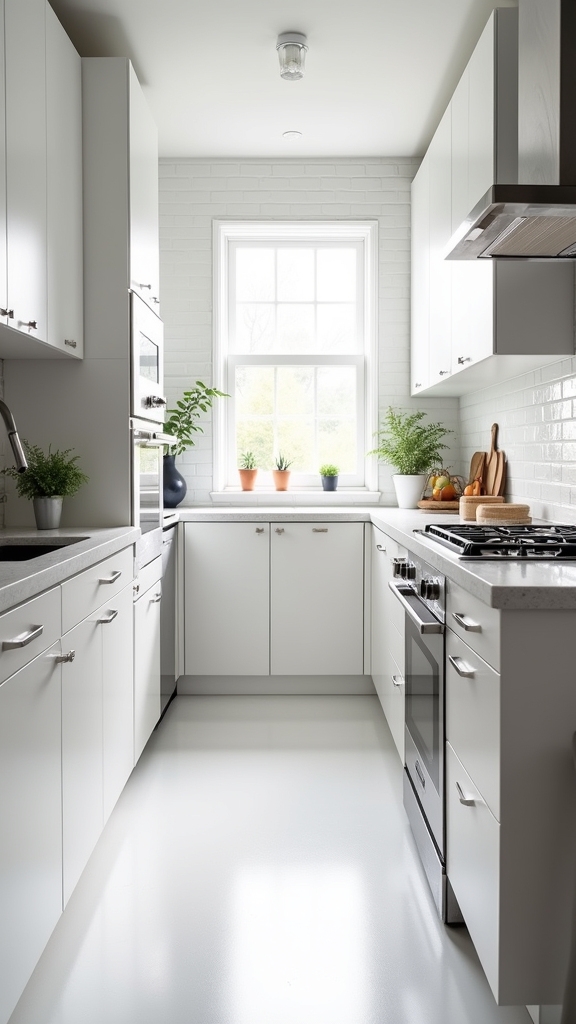
Optimizing a compact white kitchen demands strategic use of vertical storage, such as floating shelves or floor-to-ceiling cabinetry, to maximize functionality without sacrificing openness. Employing light-reflecting surfaces—including glossy cupboard finishes and marble countertops—amplifies natural illumination and visually expands the space. Additionally, integrating compact and multi-functional appliances can significantly enhance the efficiency of a small kitchen by saving valuable counter and storage space. Together, these solutions create an environment that balances utility with an inviting, airy aesthetic.
Maximizing Vertical Storage
While square footage often dictates the functionality of a kitchen, strategic vertical storage transforms limited space into an efficient and visually cohesive environment.
In white kitchen interiors, utilizing every available inch is essential. Extending kitchen cabinet units to the ceiling not only maximizes storage but also contributes to a seamless, uninterrupted aesthetic.
Open shelving or floating shelves introduce opportunities for both display and accessibility, while hooks and racks on walls guarantee essentials remain within reach yet off counters.
Vertical pull-out cabinets and slim pantry units optimize narrow wall spaces, providing tailored solutions for organization. For underutilized zones, the tops of cabinets serve as ideal storage for infrequently used items or decorative baskets.
Consider these expert-approved strategies:
- Ceiling-height kitchen cabinet installation
- Floating shelves for decor and cookware
- Vertical pull-out pantry solutions
Light-Reflecting Surfaces
When natural light is at a premium, integrating light-reflecting surfaces becomes a fundamental strategy for visually enlarging compact white kitchens. High-gloss white cabinetry, paired with polished countertops such as quartz or marble, amplifies available light by effectively bouncing illumination throughout the space.
Reflective backsplash materials—like glass or mirror-polished tiles—add depth, dimension, and a sleek, contemporary aesthetic while supporting the overall brightness. These light-reflecting surfaces not only optimize spatial perception but also contribute to a cohesive, modern kitchen palette.
Strategic lighting solutions, such as under-cabinet LEDs, further enhance the reflective qualities of these finishes, ensuring even dim corners remain luminous. By prioritizing such surfaces, designers can transform small, enclosed kitchens into environments that feel open, airy, and visually expansive.
Bright and Airy Design
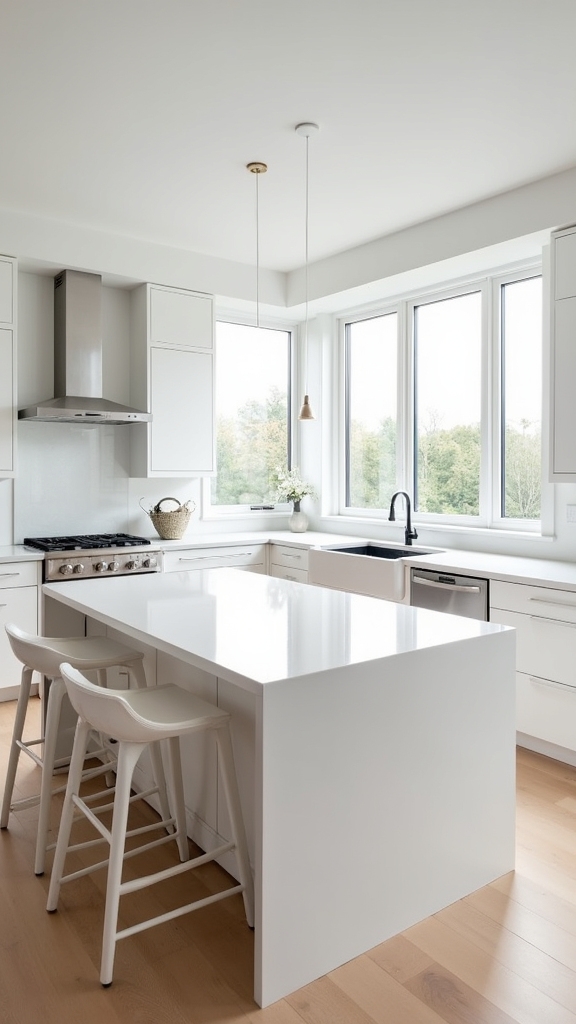
By utilizing the reflective qualities of white cabinetry and walls, a bright and airy kitchen interior maximizes natural light to create an expansive, inviting environment.
This design principle leverages high light reflectance values (LRV) to amplify natural illumination, ensuring the space feels open and tranquil.
Large windows or glass doors act as architectural focal points, introducing abundant daylight and visually extending the kitchen’s boundaries.
To enhance the bright and airy design, consider these practical solutions:
- Opt for open shelving in place of upper cabinets to reduce visual weight and foster openness.
- Select light-colored countertops, such as white marble or quartz, for seamless cohesion with cabinetry and to boost luminous appeal.
- Incorporate sheer curtains or light textiles for softness and to maintain the ethereal, unobstructed atmosphere.
An open storage concept can further enhance the kitchen’s modern look and functionality by utilizing sleek, minimalist shelving solutions.
Colorful Artistic Accents
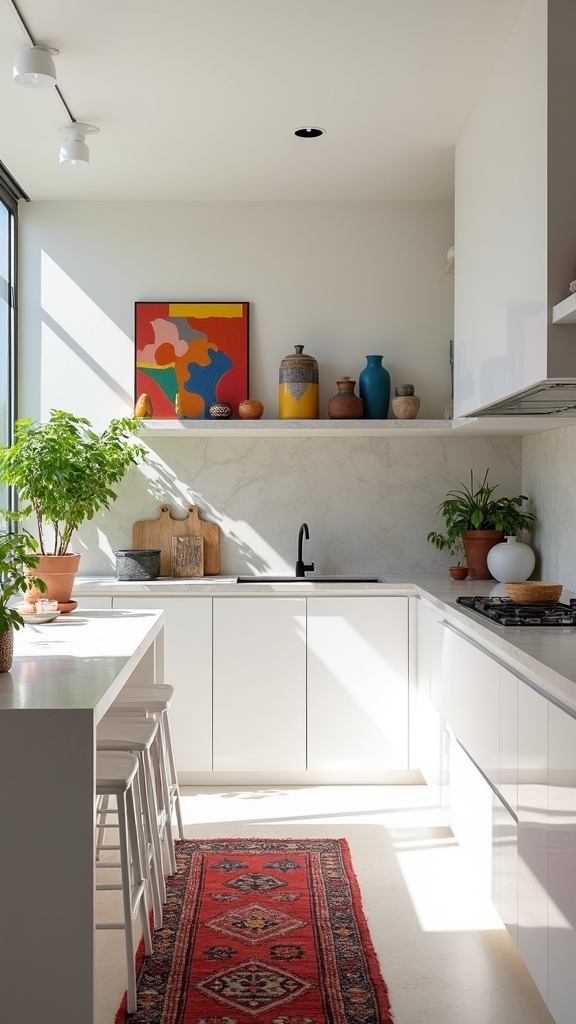
Although a white kitchen exudes clarity and sophistication, strategic integration of colorful artistic accents is essential to counterbalance potential sterility and introduce visual warmth.
Curated vibrant artwork, unique decorative objects, or hand-painted backsplashes can infuse an otherwise monochromatic space with personality and tactile interest.
Open shelving in dynamic hues—such as Portuguese Rosa marble—acts as both functional storage and sculptural focal point, elevating the kitchen’s visual narrative.
Colorful bar stools or a bubblegum pink table inject lively contrast, subtly echoing the homeowner’s individuality while harmonizing with neutral cabinetry.
Displaying richly colored dishware on exposed shelves, or featuring a high-contrast mural, cultivates dynamic interplay between form and color.
These colorful artistic accents transform white kitchens into inviting environments optimized for both culinary function and social gathering.
Bold Pigment Statements
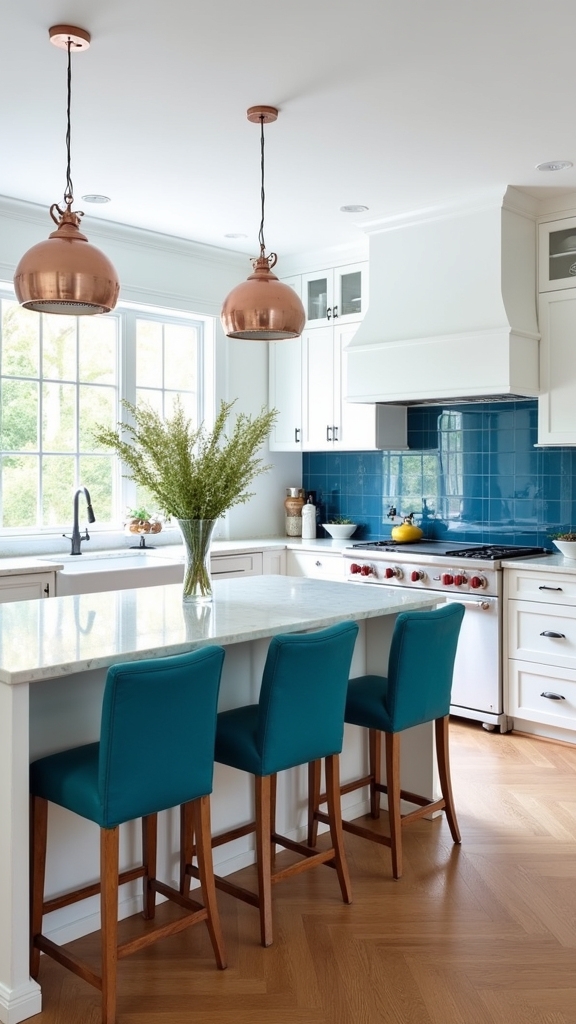
Introducing bold pigment statements through vibrant accent furniture and colorful art integration infuses a white kitchen with visual dynamism and contemporary flair.
Strategic placement of saturated bar stools or a statement banquette, combined with curated artwork, prevents monotony and establishes clear focal points.
These practical interventions offer a controlled yet expressive approach to personalizing a minimalist space.
Vibrant Accent Furniture
When bold accent furniture punctuates a white kitchen, the resulting interplay of high-contrast color and crisp minimalism enhances the entire space. Vibrant accent furniture, such as a bubblegum pink table or deep turquoise stools, acts as a visual anchor within a neutral backdrop, infusing personality without overwhelming the design.
These chromatic statements not only invigorate modern urban kitchens but also offer practical focal points that invite social interaction and expression. The strategic placement of colorful furnishings guarantees that the kitchen remains dynamic while maintaining architectural clarity.
- A patterned banquette introduces warmth and an inviting atmosphere for casual dining.
- Custom shelves in saturated hues serve as both storage and sculptural elements.
- Artistic chairs in bold pigment provide ergonomic function and aesthetic intrigue.
This approach balances minimalism with curated vibrancy.
Colorful Art Integration
While white kitchen schemes excel in architectural clarity, the integration of colorful art injects vibrancy and visual intrigue without disrupting the minimalist foundation. Thoughtfully curated colorful artwork—such as prints by Jean Cocteau—imparts personality and energy, transforming sterile expanses into dynamic environments. Bold pigment statements, whether in the form of a bubblegum pink table or vivid turquoise rainforest wallpaper, serve as powerful focal points that punctuate the space. Practicality meets artistry with custom shelves featuring colorful accents like Portuguese Rosa marble, blending storage with visual delight. Wall-mounted pieces or decorative accessories harmoniously balance the kitchen’s clean lines and creative expression. Ultimately, the selection of artwork and vivid decor enables homeowners to imprint their unique style, turning a white kitchen into a lively, welcoming culinary haven.
| Emotion | Art Element | Impact |
|---|---|---|
| Joy | Bubblegum Pink Table | Energizes |
| Serenity | Turquoise Wallpaper | Invigorates |
| Inspiration | Cocteau Artwork | Stimulates Creativity |
Warm Wood Elements
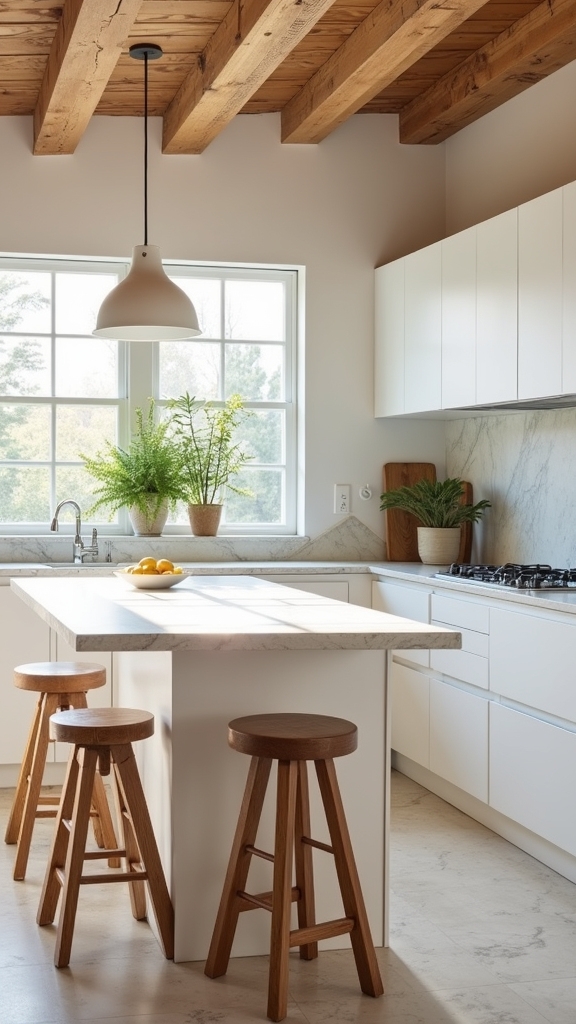
A thoughtfully balanced integration of warm wood elements can transform a white kitchen from stark to inviting, infusing the space with natural warmth and visual depth.
Utilizing wood tones such as oak or walnut for cabinetry, countertops, or accent beams not only introduces organic texture but also creates a sophisticated contrast against crisp white surfaces. This combination fosters a harmonious interplay between modern minimalism and rustic charm, making the kitchen both functional and visually compelling.
The strategic placement of warm wood accents softens the overall aesthetic, resulting in a space that feels both refined and welcoming.
Consider these expert applications:
- Wood flooring: Grounds the room and adds tactile depth.
- Butcher block countertops: Offer both durability and warm visual contrast.
- Exposed ceiling beams: Create architectural interest and rustic appeal.
Open Shelving Display
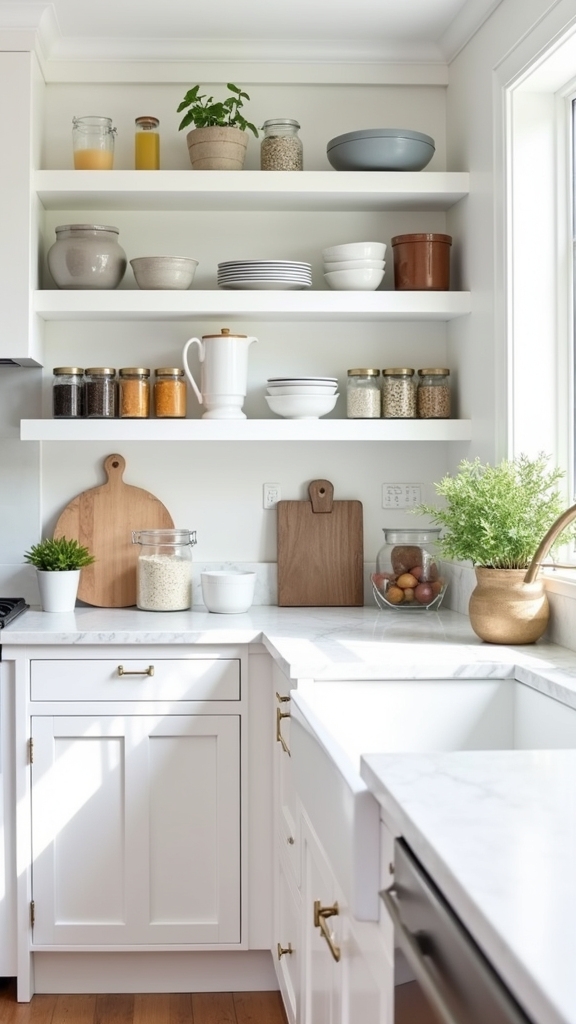
Open shelving introduces an element of visual openness to white kitchen interiors, simultaneously maximizing storage potential and enhancing the display of curated dishware and decorative accents. Expertly integrated, open shelving solutions foster an airy environment by eliminating bulky upper cabinetry, a strategic move particularly advantageous in compact kitchens.
Floating shelves, meticulously color-matched to cabinetry, reinforce design cohesion while offering a versatile platform for personal expression through carefully arranged cookware and artful objects. This approach necessitates disciplined organization, as exposed storage compels consistent orderliness and visual harmony.
For added sophistication, open shelving can incorporate subtle backlighting or under-cabinet illumination, accentuating displayed items and imparting inviting warmth to the space. Collectively, these elements amplify both functionality and aesthetic appeal in contemporary white kitchen designs.
Stylish Seating Choices
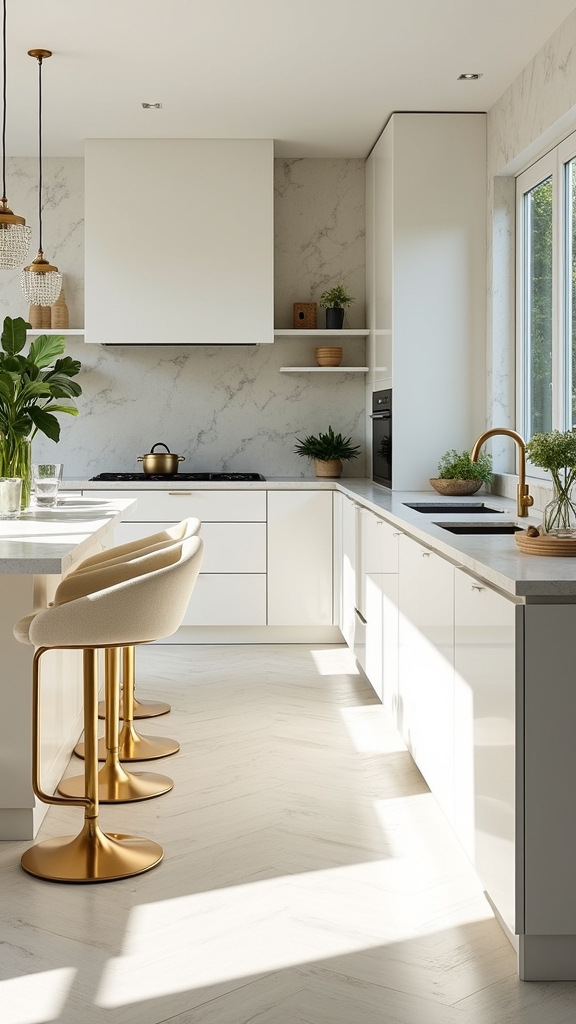
Thoughtfully selected seating solutions enhance both the functionality and ambiance of a white kitchen, serving as pivotal elements that encourage comfort and sociability.
Integrating seating with intentional style and ergonomic consideration transforms the kitchen into a dynamic space for gathering. Design experts often highlight that seating—whether for a breakfast nook or a kitchen island—should align with both the spatial flow and the visual language of the kitchen.
Intentional seating design transforms kitchens into dynamic gathering spaces, seamlessly blending comfort with the room’s overall flow and aesthetic.
Employing designer stools, such as Carl Malmsten’s, or custom slipcovered options, injects warmth and subtle contrast, while maintaining the kitchen’s clean aesthetic.
Consider these practical and stylish seating choices:
- Channel-tufted banquettes create an inviting nook for casual dining.
- Brass-accented stools introduce metallic sophistication and unity.
- Curved island seating enhances accessibility and encourages interaction.
Creative Material Mixing
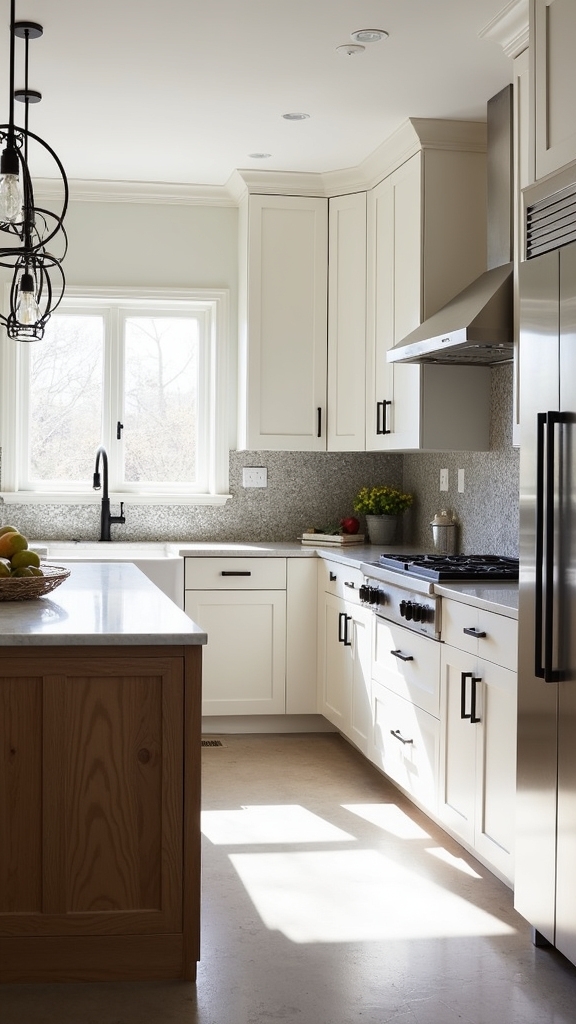
While seating sets the tone for comfort and connection in a white kitchen, material mixing defines its visual depth and tactile appeal.
Creative material mixing leverages the inherent versatility of white, allowing for striking contrasts and refined cohesion. A sleek white marble countertop juxtaposed with rustic wooden cabinetry introduces warmth and layered texture.
Integrating grained wood or brushed metal finishes beside glossy white cabinets enhances sophistication and spatial intrigue. Designers often employ dual countertop materials—pairing white quartz with a dark wood island base—to highlight individual elements while sustaining unity.
The application of a white ceramic backsplash accented with brass fixtures raises elegance without overwhelming subtlety. Incorporating unique features such as patterned tiles or colorful bar stools personalizes the space, ensuring the white kitchen remains timeless yet distinctly individual.
Pairing greige cabinets with white countertops creates a striking contrast that enhances spaciousness and brightness, offering a timeless design versatility.
Retro Influences

Drawing inspiration from mid-century aesthetics, retro influences introduce nostalgic character to white kitchen interiors through deliberate use of color, form, and detailing. Key elements such as vintage O’Keefe & Merritt stoves and hand-painted tiles transport the culinary space to the 1950s, while maintaining the crisp freshness associated with a white kitchen.
Rounded cabinetry edges and curved furnishings soften the overall geometry, offering a counterpoint to contemporary sharp lines and creating a welcoming atmosphere. To reinforce the retro theme, designers often incorporate playful details that evoke a sense of period authenticity:
Curved cabinetry and playful details transform a white kitchen, balancing modern lines with nostalgic retro character and inviting warmth.
- Checkerboard flooring or pastel accents for visual contrast
- Patterned backsplashes reminiscent of vintage diners
- Vintage-inspired hardware, such as aged brass or colorful ceramic knobs
These practical solutions infuse a white kitchen with timeless retro influences and distinctive personality.
Symmetrical Styling
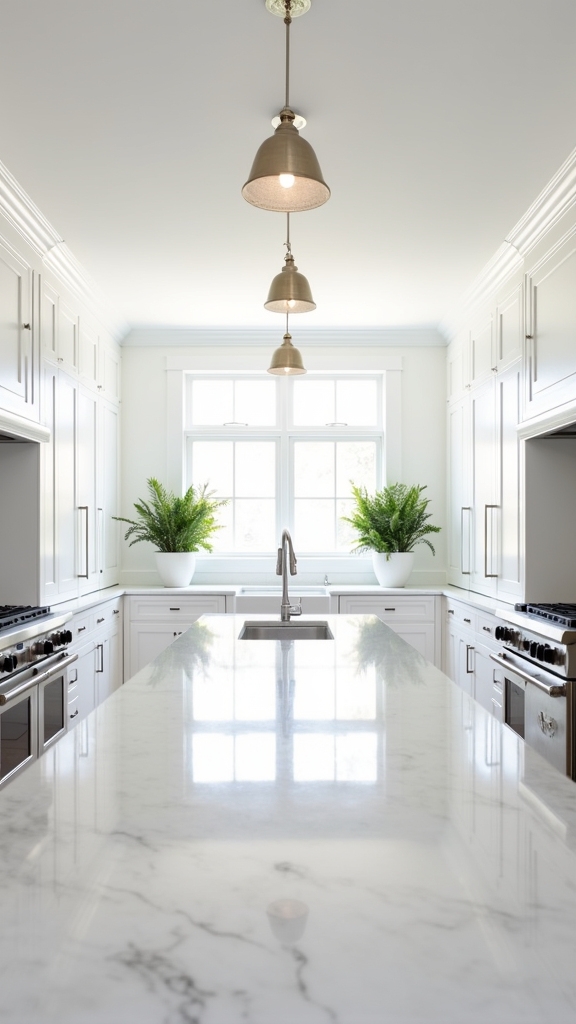
Retro motifs offer playful nostalgia, yet many white kitchen interiors achieve their impact through the disciplined order of symmetrical styling. This approach prioritizes balance, utilizing mirrored cabinetry, evenly distributed hardware, and parallel shelving to establish visual harmony.
The kitchen island serves as a pivotal axis, with designers often specifying identical bar stools or pendant lighting to reinforce symmetry and direct the eye centrally. Functional efficiency is also enhanced; appliances and storage are strategically arranged to optimize workflow, each element mirrored for seamless access and usability.
Symmetrical placement of framed artwork or decorative objects introduces elegance while upholding the crisp, uncluttered aesthetic inherent to white kitchens. Through methodical spatial planning, symmetrical styling delivers both visual unity and practical functionality in modern kitchen design.
Soft Pastel Palettes
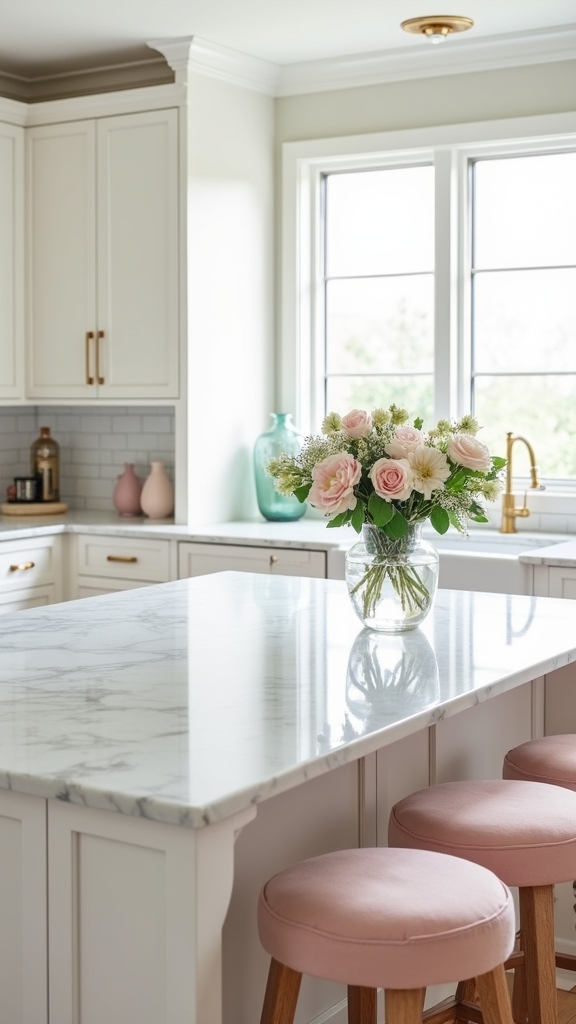
By introducing soft pastel palettes—such as hushed pinks and muted blues—designers can infuse a white kitchen with understated color, achieving a tranquil yet sophisticated environment.
These soft pastel palettes enhance the serenity of an all-white backdrop, reflecting light to amplify brightness and create an airy ambiance. Their subtle chromatic presence supports contemporary preferences for calm, understated elegance while maintaining a cohesive, modern aesthetic.
For practical integration, consider:
- Incorporating pastel dishware or textiles: Soft furnishings, like seat cushions or curtains, add gentle pops of color.
- Pairing with white cabinetry and countertops: This guarantees a seamless, timeless appeal.
- Using pastel-hued accessories: Vases, small appliances, or wall art deliver visual interest without overwhelming the design.
Such strategic use of soft pastel palettes revitalizes and personalizes white kitchen interiors.
Frequently Asked Questions
How Do I Keep White Kitchen Surfaces Clean and Stain-Free?
Maintaining pristine kitchen surfaces requires consistent Cleaning Tips: promptly wipe spills, utilize non-abrasive cleaners, and apply sealants on porous materials. Regular maintenance prevents discoloration and surface etching, ensuring a visually immaculate and hygienic culinary environment with minimal effort.
What Lighting Works Best in an All-White Kitchen?
Selecting ideal lighting options is essential for enhancing an all-white kitchen’s visual dynamics. Experts recommend layered illumination—recessed ceiling lights for ambient brightness, pendant fixtures for focal points, and under-cabinet LEDs to accentuate surfaces and guarantee practical task lighting.
Are White Kitchens Harder to Maintain With Pets or Kids?
White kitchens may present increased maintenance challenges with pets or kids due to visible stains and scratches. Experts recommend pet friendly solutions such as durable, stain-resistant surfaces, matte finishes, and integrated storage to visually minimize wear while ensuring practical upkeep.
How Do I Prevent a White Kitchen From Feeling Too Sterile?
To prevent a space from feeling overly sterile, designers recommend integrating texture variety through tactile surfaces, natural wood, soft textiles, and layered lighting. These elements introduce warmth, visual interest, and a welcoming ambiance while maintaining a cohesive aesthetic.
What Countertop Materials Pair Well With White Cabinetry?
Selecting appropriate countertop combinations is essential for visual harmony with white cabinetry. Expert recommendations include quartz for durability, marble for elegance, butcher block for warmth, and concrete for modernity—each offering distinct textural contrast and functional practicality.
Conclusion
A white kitchen remains a timeless canvas, adaptable to myriad design directions. By integrating high-contrast accents, layering textures, or incorporating subtle pastel palettes, homeowners can achieve both visual interest and enduring functionality. Expert use of materials—marble, wood, or metals—elevates the space, while preserving historic elements or adopting minimalist layouts guarantees longevity. Ultimately, these strategies offer practical, visually cohesive solutions, empowering any remodel to seamlessly balance sophistication, comfort, and modern efficiency in the heart of the home.
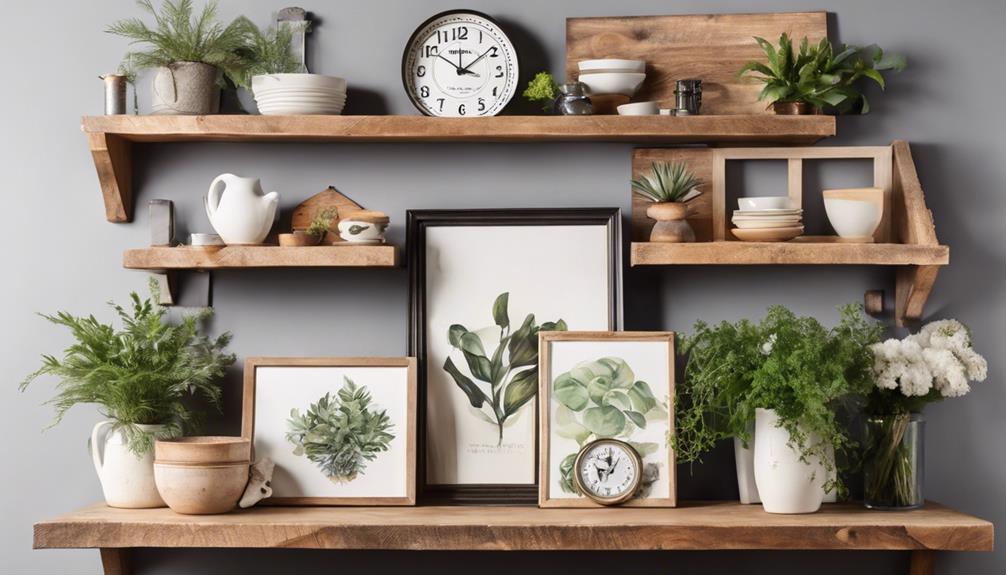
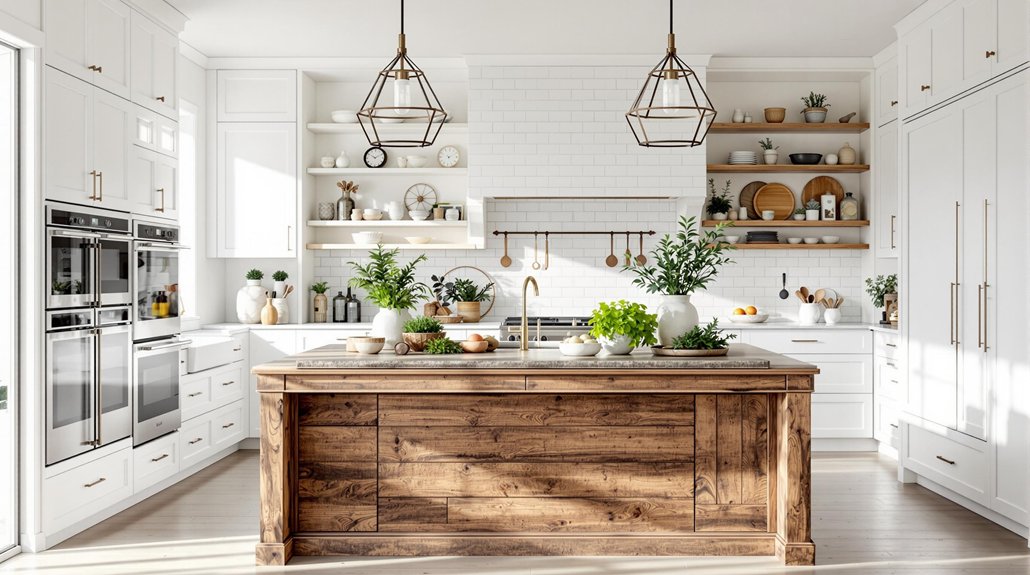

Leave a Reply